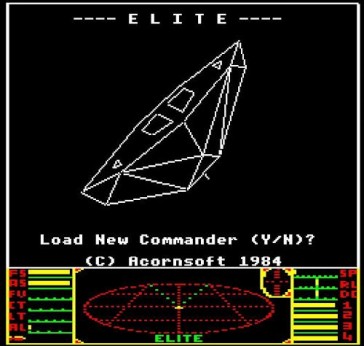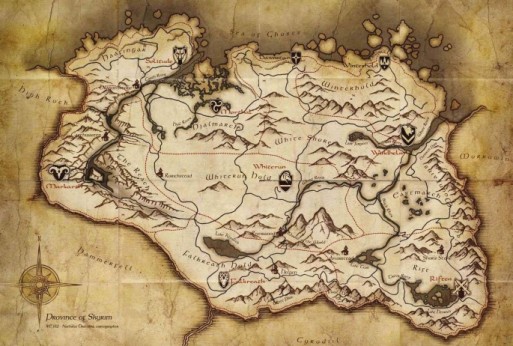
Insert Currency
Insert Currency: Skyrim – Oh the Places You’ll Go
Skyrim is the bukkake love-child of a myriad different games. Expansive open world, hand-crafted dungeon crawls, a classless class system, strong RPG character and story elements, and moral decision making, join in a glorious choir of M-rated harmony. In this figurative DNA-test we will look at the parentage of Skyrim’s open-world frontier. The transition from Elite, Legend of Zelda, Super Mario 64, and into The Elder Scrolls series is like witnessing a cocoon mature and give birth to a beautiful nordic mountain range.
Modern games have gotten big, I mean really big, in the sort of way that suggests their budgets must be as procedurally generated as their forefathers games. Elite only required 16kb of memory but contained 8 galaxies. Skyrim, a 6gb game, would produce roughly 8,914,560 galaxies of similar complexity. If you pretended that number was square miles, it would then represent 111,432 times the size of vanilla WoW. Older games didn’t lack grand vision, only the hardware required to execute them in full. In spite of these limitations Elite was released in 1984 with early 3D graphics, multiple planets to explore, and a model of ship combat, missioning, and commodity-trading, which can be easily recognized in contemporary games such as EVE Online.
Skyrim, on the other hand, seems to be the product of a designer that found himself physically incapable of saying no. Gigantic landmass? Yes. Soaring mountains with shifting weather patterns? That sounds…. doable. Multiple different towns and orc clans with distinct histories and cultures? Well, if you’re going to twist my arm. 150 unique, handcrafted dungeons requiring a team larger than most small games studios to design? … Ok. Skyrim is ambition incarnate, and even if it didn’t entirely succeed at all of its undertakings it shares the spirit of Elite’s striving to be bigger than anyone thought possible. Skyrim, however, was fortunate enough to have decades of lessons and experience to draw from.
Some of these lessons seem simple, but were important. In ELITE a galaxy could spawn beyond the fuel reach of its neighbors. This resulted in players being stranded in the cold existential-horror of space. Procedurally generated worlds have continued to be popular for games that want to offer an expansive environment but don’t have the resources to craft them. This isn’t limited to low-budget productions; even mega-hits, such as Diablo 3, are based around this concept.
The other direction is to hand-sculpt the world, more Raphael than Pollock. An early example of this approach is The Legend of Zelda. If you are like me you had a laminated map of the game world by your side at all times and a stack of Nintendo Power (RIP) magazines to reveal dungeon layouts on-hand and indexed. Building a static world creates a much greater opportunity to sculpt the player experience. Knowing the approximate route the player will take allows a game designer to create appropriate challenges. For example [spoiler alert] a bomb is needed to defeat Dodongo, the boss of an early dungeon. Specific requirements like this are only possible when a game world is predetermined enough to ensure a player has access to bombs by this time. Zelda represents this delicate balance of giving players the freedom to roam and take on challenges at will, while also balancing the need to scale the difficulty of encounters and access to more powerful items. It is for this reason defeating each dungeon rewarded additional maximum-life and often included a new weapon or tool. This approach to power growth still limits a player’s freedom substantially. It’s a bit like being able to have whatever you want for dinner so long as it’s broccoli.
Nintendo addressed this problem head-on with Mario 64. The need to scale difficulty with player skill is an ever-present problem in games. Giving a new player a difficult set of challenges can discourage them from playing more and becoming proficient enough to overcome them. An entirely free-roam experience can result in demoralized players. To combat this Mario 64 places levels into difficulty tiers, requiring specific number of keys be found from the available pool of levels before opening up the next set of levels. By slowly increasing the difficulty of each tier Nintendo was able to ensure players had the freedom to play in multiple dungeons, but only those within their skill level. It is a testament to their success at balancing these competing forces that the game became so popular.
From these two methods, Zelda’s open map and Mario 64’s access to multiple dungeons, was born the method used in Skyrim. Everything becomes available. The entire map and dungeons can be explored and tackled solely because Bethesda has learned to scale the monster difficulty well. This advancement negates the need to have the Golden Smashy Hammer from dungeon 37 in order to breakdown the Strangely Resistant Door to dungeon 38.
This method solves the closed world problem that has plagued many earlier games, and it does so in an elegant way, scaling monsters upon first contact to be difficulty-appropriate. Released from the need to guide players through a specific difficulty sequence, Skyrim was able to take on the size and shape it did in a manner that would have been impossible in an earlier generation of games. It does, however, create a new set of problems, which will be discussed in the next part, of making it difficult to have meaningful story decisions, which are the cornerstone of RPGs.

